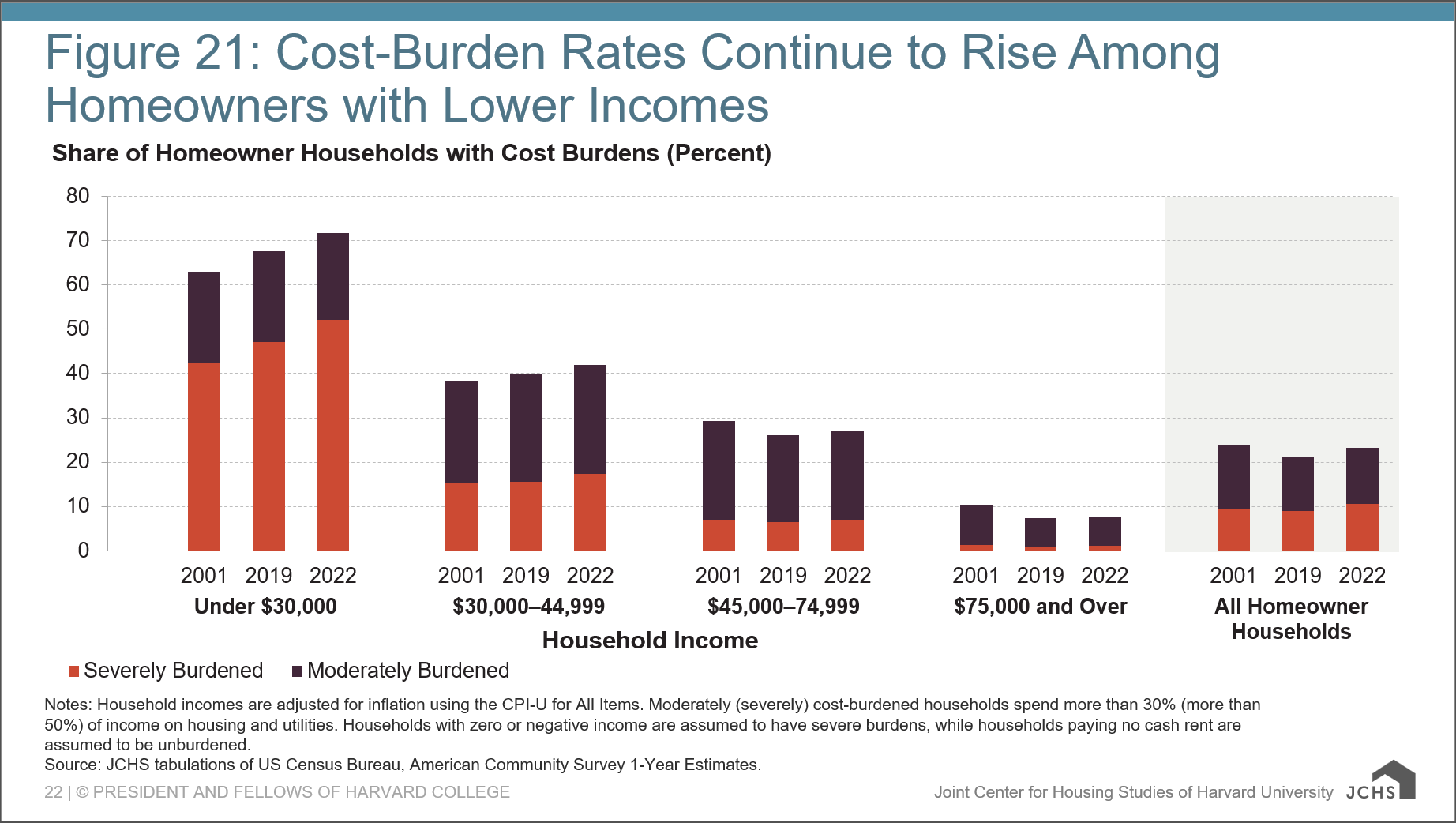State of the Nation's Housing 2024 Report Summary
Every year, the Harvard Joint Center for Housing Studies releases a report on The State of the Nation’s Housing. The 2024 report analyzed several components of the U.S. housing market and reported on current housing challenges affecting both renters and homeowners. The State of the Nation's Housing 2024 helped paint a clear picture of growing housing challenges and the need for an all-hands on deck approach in which,
“All stakeholders must work together to address the affordability crisis and many related urgent housing challenges, including the inadequate housing safety net, the record number of people experiencing homelessness, and the growing threat of climate change. ”
Figure 21 below illustrates the cost-burden rates among homeowners, with notably higher rates among households with the lowest incomes including older adults. This group is also much more likely to live in substandard housing due to financial constraints.

“A shocking 95 percent of older adult homeowners with low incomes and mortgages are cost burdened, dramatically higher than the 56 percent of their counterparts who own their homes outright and the 74 percent of those who rent. ”
Other key takeaways from The State of the Nation's Housing 2024 report as they relate to the Coalition’s work and mission are:
- Rising costs: Homeowners with low-incomes are more likely to live in substandard housing and delay (or forego) addressing various problems related to plumbing, heating, electrical writing, and maintenance, threatening their household stability, overall.
- Cost-burden rates are rising - as of 2022, nearly 20 million homeowners are cost-burdened, spending more than 30 percent of income on housing and utilities (an increase of 2%, or roughly 3 million households from 2019).
- Home insurance premiums increased an average of 21 percent between May of 2022 and May of 2023.
- Single-family property taxes also grew an average of 4.1 percent in 2023.
- Disproportionate impacts: Homeowners of color are more likely to experience housing inadequacy. Approximately 9.6 percent of American Indian/Alaska Native and 5.7 percent of Black homeowners live in inadequate housing, compared to 3.4 percent of all homeowners.
- Construction trends are diverging:
- Despite persistently higher interest rates, single-family construction is increasing while multi-family development declines.
- Manufactured home shipments show a 21 percent annual decline.
-
Accessibility: While 22 percent of adults age 65 or over report challenges walking or climbing stairs, fewer than 4 percent of homes offered the three foundational features of accessible housing (single-floor living, no-step entries, and wide hallways and doorways). Paying out of pocket for these accessibility modifications is not an easy endeavor for older adults.
-
Need for climate resiliency, recovery, and retrofitting efforts:
- According to FEMA's National Risk Index, 60.5 million units are located in areas with a moderate risk of damage from climate related disasters.
-
The energy consumption for homes built before 1950 is 45 percent higher than that of homes built in the five years leading up to 2020.
Moderated by Jennifer Ludden (NPR), the release event also featured an insightful panel discussion with Chris Herbert (Harvard Joint Center for Housing Studies), Priya Jayachandran (National Housing Trust), Chrystal Kornegay (MassHousing), and Sheryl Palmer (Taylor Morrison).
“How powerful would it be to have this one two punch of creating more supply and helping people with their housing stability [all while helping] our preservation challenges.” - Priya Jayachandran
You can access the webinar recording, full report, and interactive maps and data here.
Coalition for Home Repair's Advocacy Platform
The report emphasized a growing need for policy solutions that adequately respond to the alarming findings impacting low-income households. The Coalition for Home Repair recently hosted its third Advocacy Task Force session, which featured a presentation by Coalition members Good Works and Good Neighbors on their Whole Home Repairs Coalition. Following the presentation, Advocacy Task Force members brainstormed on establishing concrete policy priorities for the Coalition's national advocacy agenda, ensuring the input of a diverse group of thought leaders. They include:
-
Increasing equitable access to home repair and modification programs through sustained, multi-sector partnerships with community-based organizations, institutions, national advocacy partners, and all levels of government.
-
Safeguarding low-income households from substandard housing conditions and predatory practices that may result in displacement of vulnerable households.
-
Expanding access to education and counseling for aspiring and current homeowners on home maintenance and estate planning.
We intend to continue advocating, to the highest degree, how essential it is to consider home repair as a proactive solution to preventing homelessness, stabilizing entire communities, and improving the health and safety for all. Consider following along and participating in our advocacy journey:

